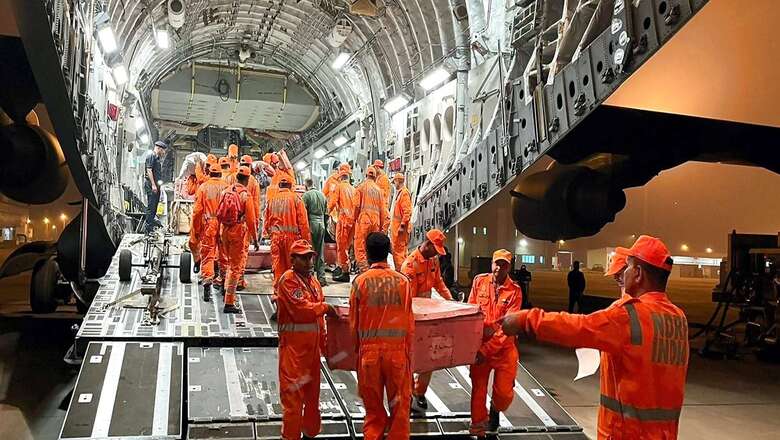
views
India-Turkey bilateral ties can be simply explained by the bittersweet rapport that the two nations share. Usually warm and cordial, albeit with some sporadic tensions, these two find a reason occasionally, to shake up their good ties. Thinking about these nations almost always brings back the thrill of a roller-coaster ride in the minds of many. Things become interesting when you watch Turkey siding with Pakistan on matters prevailing in Kashmir, while India being no less on the offensive strongly condemns deep involvement of Turkish Government and military movement in northeastern Syria.
Historically speaking, India always stood by Turkey, case in point when MA Ansari (Indian freedom fighter) led a medical mission to Turkey in a war against Balkans to help war victims. India also supported Turkey when it was revolting to abolish its Ottoman rule and monarchical government at the time. For this, the latter acknowledged Indian contribution and extended its friendly hand that put into motion what we see and know as bilateral ties between the two nations today.
India is popularly known as ‘Hindistan’ or ‘Indistan’ in Turkey among locals. Irrespective of its government’s stand in UN, which is against India, the Turkish consider Indians as their friends and fondly speak about the various Bollywood movies and Indian TV soap operas that have increased their familiarity with India and Indian culture overtime. They respectfully recall Mahatma Gandhi for his valuable support to Turkey during their independence movement.
CUT TO FEBRUARY 8
In the aftermath of three fatal earthquake jolts, ‘60 Para field hospital’, a support group based out of Agra, was one of the first to step up to help Turkey under ‘Operation Dost’. Within 48 hours of the calamity, this field hospital was made operational by a 99-member team on Turkish soil.
Teams from the country’s European neighbours France and Spain started to arrive much later.
This team of volunteers offered critical care treatments to survivors that were being taken out of rubble at rescue sites. The 60-para field team was equipped with X-ray machines, ventilators, oxygen generation plant, cardiac monitors, and all requisite paraphernalia to establish a 30-bed hospital on the go. More than 4,000 survivors were treated, and countless lives saved, thanks to these Indian superheroes.
Meanwhile, the Turkish government demonstrated undetermined faith in Indian teams to the extent that even Turkish medical teams were instructed to assist Indian doctors to make more make-shift facilities to ensure first aid in towns that withstood maximum devastation.
Indian teams were initially allocated a school building to operate from, but due to constant aftershocks, the team decided to vacate and shift their entire setup in tents, prioritising the rescue job at hand over risk to their own lives while braving the chilly winters of Turkey.
Colonel Yaduvir Singh, who handled operations at the hospital, said, “We were the first to set up the hospital after the first round of tremors. Our functioning is so smooth and effective that immediately after treatment we decongest the hospital by sending patients to bigger hospital so that space can be created for the next patient."
HELP AT HAND
Alongside India and other nations, international agencies such as INSARAG, a UN agency comprising more than 90 member countries, dealing with urban search and rescue (USAR) related issues, worked on ground with an aim to establish minimum international standards for USAR teams and methodology for international coordination in earthquake response based on the INSARAG Guidelines.
Additionally, AFAD, a disaster & emergency management agency, which ranks highest internationally for its impeccable response in disaster management, operated in full swing in Turkey. The United Nations, having known about the ability of Indian Teams’ (NDRF) disaster management capabilities from experiences in Nepal and Japan, asked the NDRF to create a sector independently, however, officers had to turn it down as they were not informed earlier and therefore could not carry the requisite setup to do so and also out of respect and protocol to work in coordination with senior teams which are INSARAG verified.
NINE SECTORS
The rescue work was divided into nine sectors and classified teams were given sectors to handle so as to create a control room called the Sector Coordination Cell with the logic to make smaller teams report to these cells who would then pass on rescue updates to the central cell.
Of the nine sectors, Indian teams were deployed in two places, two teams were deployed in Nooredagi and one team in the worst affected province of Antakya.
Indian teams performed at par with other international teams and rescued two children — one after 80 hours and the other after 105 hours from under the debris. NDRF Dog Squad Romeo and Julio sniffed a site and alerted teams about someone stuck alive after which Sadat, a local resident, was successfully rescued.
Indian teams worked at more than 50 affected sites of devastation. Officers in NDRF told News18 that initially there was a JCB crisis as they were being provided by AFAD, but many JCBs were stuck in traffic or could not reach so Indian teams were asked to clear the debris and start search and rescue work at site. Following this, Indian teams immediately got into action, cleared the debris, speeding up the rescue operation.
The NDRF was also given access to the OSOCC platform, which is otherwise only given to classified teams handling independent rescue sectors. This helped the team access and update real-time disaster management data.
NDRF Commander Gurminder Singh spoke on the classification of Indian Teams: “ As far as training of rescue volunteers is concerned, it is as per the benchmarks of any accredited international disaster management agency. Our first responder course is as good as the UN’s first responder course and that is the reason, we managed to excavate two lives and 83 bodies from the rubble."
Vishwanath Parashar, second in command NDRF officer, said, “We could not sleep for record 48 hours as long travel time had already caused delay, but without even taking a nap our jawans started S&R works and the moment we rescued a girl child alive. We had forgotten all our pain and sleep deprivation with an intention to double our rescue work."
Before leaving Turkey, Indian teams decided to leave all ration and medicines which they had carried with them for further rescue works and AFAD has handed them over to the team from Vietnam. Going forward, Indian teams are in the process of getting classified and in 2019, the first round of assessments for the same has already taken place, but due to Covid, the process lost momentum.
However, the rescue operation in Turkey, in addition to past work, has made a very strong case for the Indian team’s successful classification.
By saving hundreds of lives and providing timely aid to the needy, India has not only validated its friendship with Turkey, but has also generated global affection, appreciation and admiration.
With a hope that ‘Operation Dost’ will positively determine the proximity of political-humanitarian ties between Turkey and India, Indian teams for now have flown out of Turkey.
As they say a friend in need is a friend indeed, India continues to lend its support to Turkey and its citizens to strengthen the foundation of this important friendship.
Read all the Latest India News here

















Comments
0 comment